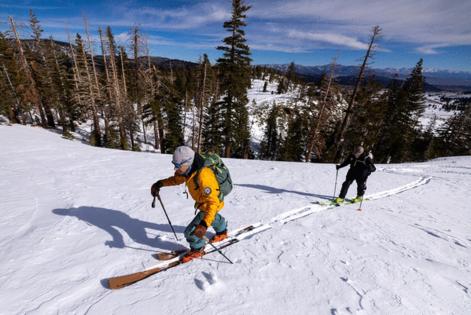Frustrated with crowded resorts in California, more skiers risk avalanche hazards in backcountry
Published in News & Features
MAMMOTH LAKES, Calif. — On a clear, cold day in mid-February, we had spent hours on backcountry skis trudging up and across a remote mountainside in the eastern Sierra when we noticed that the trees directly above us were much smaller than the others we had passed along the way.
Still panting from the workout, I looked down the steep slope — something I had carefully avoided up to that point — and saw more suspiciously small trees stretching below us.
"Avalanche," said my ski partner, Howie Schwartz, a veteran backcountry guide. "Huge one, back in the '80s, reached all the way down to the valley."
To his trained eye, the nearly vertical strip of new growth was a telling sign that we were slogging across the high-alpine version of a bowling alley. On the wrong day, tons of snow piled on the ridge a thousand feet above could release without warning and crash down like a wave that, instead of washing over us, would bury us and quickly solidify into the consistency of concrete.
The odds were firmly in our favor that day: There had been no new snow recently or abrupt changes in the temperature. Still, it was best not to linger, Schwartz said, with a nod to make sure I followed him across to the taller trees.
Avalanches are an unavoidable fact of life in the mountains. Two days after our trip, following a storm that dumped six feet of snow in 36 hours, a pair of ski patrollers were caught in an avalanche at nearby Mammoth Mountain resort. One was extracted without serious injury; the other is fighting for her life in a Reno hospital.
On the same day, two small avalanches struck at Palisades Tahoe. Nobody was injured, but a year ago four people were trapped and one died in an avalanche at the resort.
As shocking and sad as those cases are, they happened on some of the most aggressively protected slopes in the world. Large commercial ski resorts such as Mammoth and Palisades employ patrol teams that go out every morning before the lifts open to test the stability of the snowpack.
If anything looks suspicious, they deliberately trigger avalanches — using explosives for big stashes of snow, using their skis and body weight for smaller ones — in the hope that no unexpected slides will occur when paying customers are enjoying themselves downhill.
But if things can go wrong at carefully managed resorts, imagine how much risk there is in the backcountry where nobody patrols, cellphone signals are spotty and, even if you can make a call, help might take hours to reach you.
On Monday, a 46-year-old backcountry skier was killed in an avalanche just south of Lake Tahoe. Due to what deputies called "extremely hazardous" conditions, it took an El Dorado County search-and-rescue team more than 24 hours to retrieve the body. They had to use explosives to set off avalanches in the area before it was safe for them to go in, according to a sheriff's department post on Facebook.
In the last decade, at least 245 people in the U.S. have been killed by avalanches — the vast majority in the backcountry, according to data compiled by the Colorado Avalanche Information Center and the U.S. Forest Service. Some victims were hikers and snowmobilers, but more than half were skiers.
That's a shocking number given how small the community of hardcore backcountry skiers is. Seemingly everyone who makes the sport a significant part of their lives has lost at least one friend to an avalanche.
"I know of far, far too many who have died," said Schwartz, 52, who has been guiding professionally for three decades and helped design the curriculum for the country's most commonly taught avalanche training course. "The longer you do this, the more people you know who die, even professionals, even other guides."
Despite the obvious risks, there has been a steady rise in the number of people heading to the backcountry to "earn their turns" in recent years. There was a big spike in 2020 after ski resorts shut down due to COVID-19, said Steve Mace, director of the Eastern Sierra Avalanche Center, which publishes daily updates on the weather and avalanche risk in California's high country.
But the number of backcountry skiers didn't plummet after the pandemic ended, Mace said. One reason is the eye-watering cost of lift tickets: A single day of skiing at Mammoth can cost as much as $219 this season. Another is the crowds: Despite the high cost, standing in a lift line on a holiday weekend can feel a lot like staring at taillights in rush hour on the 405 Freeway.
And then there is the resort vibe. When 19th-century California naturalist John Muir famously said, "The mountains are calling and I must go," he couldn't possibly have imagined slushy parking lots crowded with Teslas and short tempers, or bars selling $15 beers.
The allure — some would say siren song — of the backcountry is the absence of everything resorts represent.
Even on the most hectic days inside the boundaries of Mammoth Mountain, the untouched, unnamed slopes nearby offer precious silence and solitude. With no ski lifts you have to work a lot harder, but there's something purifying in the effort it takes to climb hundreds of vertical feet to reach the top of a perfect line. The descent through unimaginably light, untracked powder is the reward.
On a good day — with a knowledgeable partner and the avalanche odds in your favor — all it costs is a few calories and a bit of sweat.
With all of that in mind, Schwartz and I drove to the end of Old Mammoth Road on a recent weekday, where the gleaming vacation homes end and the landscape turns steeply up toward the Sierra crest.
We glued "skins" to the bottoms of our skis, synthetic material that allows the skis to glide forward through the snow but stops them from sliding backward, making uphill travel possible. We clicked into bindings that held only our toes in place for the uphill, and then, with a quick adjustment, locked our heels in place for the downhill run.
The temperature was well below freezing, but we left most of our layers in our backpacks, because the uphill portion would be an intense workout. We didn't want to get soaked in sweat on the way up only to freeze on the way down.
Our safety gear included avalanche beacons, devices about the size of an old Blackberry that can send and receive electronic signals. We strapped them to our chests so that if one of us got buried in an avalanche, the other would, theoretically, be able to locate the beacon.
We also had probes: long, thin sticks that unfold like tent poles and are designed to punch holes in avalanche debris to make contact with a buried partner. You hope you don't poke someone in the eye, but if you're using one, it's a life-or-death emergency, so it's no time to be squeamish. We also had collapsible shovels to help us dig if we were lucky enough to find our friend.
We pulled out all the gear and tested it at the bottom of the hill, an exercise that was more sobering than reassuring. Every step in the search-and-rescue process would take time, and someone buried in snow is likely to suffocate within minutes. It became obvious that the best way to stay safe in the backcountry would be to avoid having to use the emergency gear altogether.
That's harder than it sounds. Predicting whether a snowy hillside might slide depends on a dizzying array of factors, most of which are not obvious to the naked eye. For example, avalanches usually occur on slopes with a 30-degree to 45-degree angle. I've been skiing, hiking and climbing for nearly four decades, and I can tell you if something is steep, but the mathematical degree of its slope? I have no idea.
Another crucial factor is the way snow is layered. Think of it like a cake. Some storms are warm and wet, like frosting; others are cold and dry, like crumbly pastry. If a firm layer is resting on top of a weak layer, that's a recipe for disaster. But it's difficult to know without encyclopedic knowledge of the season's weather in that precise location, or digging a deep pit and carefully examining each striation — like performing a bit of impromptu archeology before your workout.
"If I were going to tell you one thing that really gets my hackles up, it's a persistent weak layer," said Mace, the avalanche forecaster. All the other dangers are relatively short-lived. New snow from a storm settles pretty quickly, for example. But a weak layer buried underneath the surface can last for months.
That's where the ESAC website comes in. It provides a color-coded scale of the threat level that takes into account recent weather, the nature of the terrain and the likely consistency of the layers lurking beneath the surface.
Mace, 37, worked for years as a ski patroller and mountain guide before taking on the avalanche forecasting duties at ESAC. Despite the risks, he does almost all of his skiing in the backcountry.
"It brings me a lot of joy and peace. I love the uphill as much as the down," he said. But Mace, too, said he has seen his share of tragedy. "I have been in this field a long time, and I have lost a lot of friends, people I loved."
The most valuable lesson he has learned is patience. If he sees a particularly pretty line of snow carving down through some rocks, like an elegant white necklace, he doesn't just throw on his skis, trudge up the hill and charge down, the way he did in his 20s.
These days, he studies the slope, like a gem cutter before lifting his saw. He watches the weather, assesses the layers and waits for the perfect dusting of powder. He accepts that it might take years for the stars to align.
"It's a very harsh learning environment," Mace explained, with lots of unreliable "positive feedback." You might ski something steep and wonderful, where nothing goes wrong, and think you've figured things out, he said.
"But there are a million reasons why an avalanche might not release" on any given day, Mace said. "It may not be that you made good choices; it may be that you just got lucky."
Both Mace and Schwartz said it can be hard to find the right tone when offering advice to new backcountry skiers. They don't want to underplay the dangers, but they also don't want to discourage someone from pursuing what, for them, has become a passion.
"What you see more often than not," Schwartz said, "is that people know what they're doing is dangerous. They know there's a mortal risk. But they do it anyway."
I struggled, mightily, as Schwartz and I continued up and across the rugged slope. I'm a confident resort skier, but it was my first time in the backcountry and the unmanicured conditions proved tougher than I expected.
Wind had scoured away most of the powdery snow, and rain had left a slick, brittle crust. I grunted and cursed trying to get the unfamiliar skis to go where I pointed them. Schwartz smiled patiently and said the snow was "a little grabby," anyone would struggle with it.
He didn't, though.
When we finally approached the taller trees, the crunch-crunch of every stride grew steadily softer. There, sheltered beneath the branches of the towering pines, the snow was untouched, like a hillside covered in a foot and a half of down feathers.
Schwartz grinned and said, "This is it, man, this is why we're here."
He reminded me to wait for him to get a good distance ahead. That way, if one of us kicked off an avalanche, we'd be far enough apart that it probably wouldn't swallow us both, leaving one guy free to rescue the other.
And then he turned his skis parallel with the fall line, gathered some speed and started making effortless bouncy turns through the trees. The snow was so soft, he floated hundreds of feet to the valley floor in perfect silence.
Well, almost perfect. I could hear him laughing.
©2025 Los Angeles Times. Visit at latimes.com. Distributed by Tribune Content Agency, LLC.







Comments